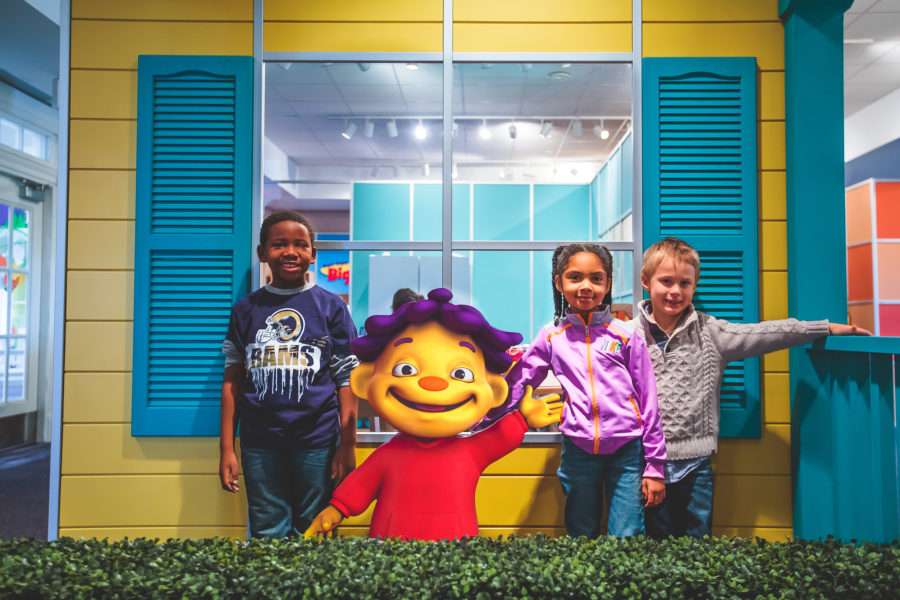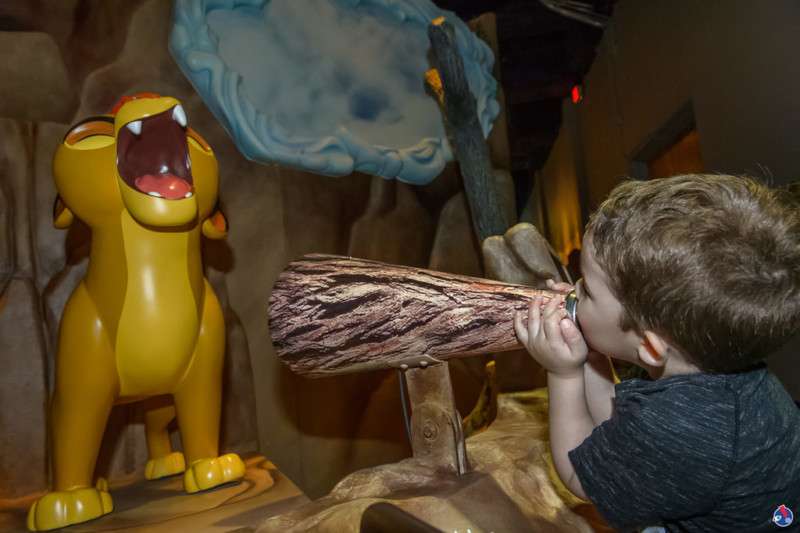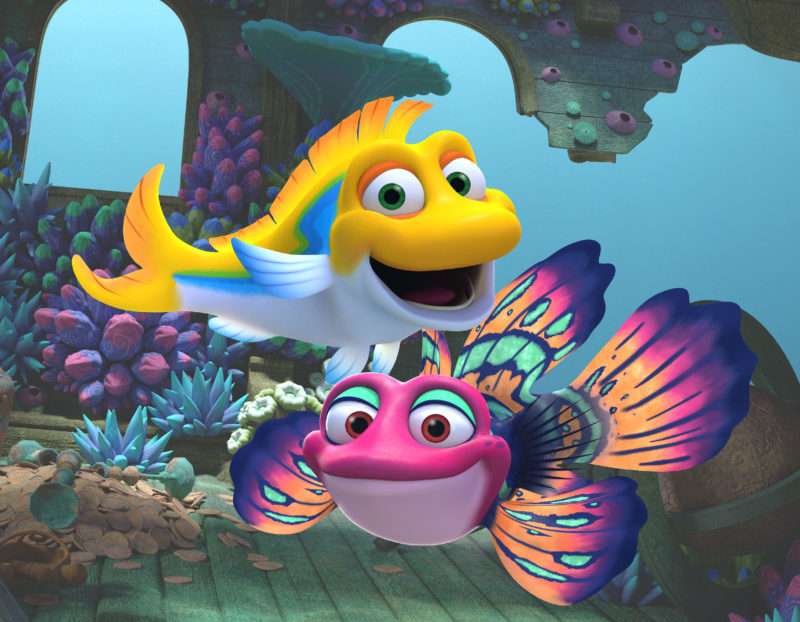Children’s museums do business with IP-based traveling exhibits
by Mira Cohen
ABOVE: “Splash and Bubbles” will begin touring after an initial run at St. Louis’ Magic House Photo ™ and ©Henson; ©Herschend Studios
Many children’s museums have found that they can drive visitation, enhance merchandising opportunities and generate revenue by creating and leasing multi-year traveling exhibits, through collaborations with intellectual property (IP) holders.
Some of the brands in play are already perceived as educationally oriented. At the same time, graphic characters representing toy and entertainment companies are highly popular among children themselves. For children’s museums, extending the reach beyond the traditional educational characters and partners can appeal to the actual audience – the children – increase foot traffic, and extend the life of an exhibit.
We talked to museum executives and to someone on the IP side to learn more about the process and the benefits.
When brand and museum mission align

“How People Make Things” is an exhibit developed and leased by the Children’s Museum of Pittsburgh. The museum owns the IP for this and other exhibits they’ve created based on factory tour videos from the classic children’s TV show, “Mr. Rogers’ Neighborhood,” working with Fred Rogers Productions. The videos bring their audiences along to tour factories with Mr. Rogers and learn about the four processes of manufacturing – cutting, molding, deforming and assembling.
We learned from Bill Schlageter, Director of Marketing at the Children’s Museum of Pittsburgh, that 25% percent of the museum’s earned income comes from traveling exhibits as well as consulting services to other institutions. It’s important to them to maintain a reputation for high standards when it comes to branding and design quality.
The identity and legacy of Fred Rogers as a son of Pittsburgh and his impact on the pedagogy and design of the Children’s Museum in Pittsburgh are uniquely intertwined. Museum marketing materials state, “Fred Rogers is a beloved icon for Pittsburgh and has been a bedrock for Children’s Museum of Pittsburgh since its inception – as an advisor, a mentor and a friend. We believe it’s important to continue to memorialize Fred’s wonderful and meaningful work, as well as help today’s children and families better relate to his many invaluable messages.”
Pittsburgh follows the typical practice of opening the exhibit first at the home institution, after which it goes on the road, returning for periodic maintenance. Pittsburgh’s model has been successful, according to what we learned from Schlageter. The exhibits have attracted thousands of visitors and traveled to dozens of locations, and are essentially evergreen, with an average lifespan of 10-20 years. And the two organizations’ mission alignment has led to them working together in other ways. Fred Rogers Productions has hired the museum team to design exhibits such as a kiosk at the Pittsburgh airport.
Bringing the ocean to St. Louis

The Magic House is a 65,000 square foot world of wonder located in St. Louis, Missouri. Its President, Beth Fitzgerald, has overseen the growth and development of the space over the past 39 years. Ms. Fitzgerald and I discussed the museum’s relationship with the Jim Henson Company and Herschend Entertainment that has led to the creation of successful traveling exhibits.
Beth’s first involvement with a Jim Henson Company property involved “Sid the Science Kid.” Beth’s goal was to engage young children in the excitement around science and she noticed that kids love Sid. In an effort to utilize that enthusiasm to bring educational value to children’s museum experiences, Beth reached out to her local PBS KIDS TV affiliate to begin the conversation that culminated in a co-branded exhibit, “Sid the Science Kid: The Super-Duper Exhibit!”
Flash – no, splash – forward, and “Splash and Bubbles: Dive In, Lend a Fin!” created by The Magic House in collaboration with Herschend Enterprises and The Jim Henson Company will begin touring in summer 2019, after having first run at Magic House. Because of the relationship that had developed with PBS KIDS, Beth and her team were invited out to see “Splash and Bubbles” in production. They were able to meet the actors, watch the advanced puppetry, and experience the technology behind the production. It was love at first sight. Beth recognized an opportunity to share ocean exploration with the children of the Midwest (who don’t have oceans nearby).
Marketing materials state, “The exhibit, like the show, helps build both STEM and social-emotional skills as children learn how to protect the ocean and its ecosystems.” Because Herschend Enterprises has a relationship with The Jim Henson Company and owns the rights to “Splash and Bubbles,” all approvals for the exhibit needed to go through Herschend. The licensing process took about a year and a half. Once this was done, concept ideas needed to be approved by both Herschend and The Jim Henson Company.
Traveling exhibits bring in five percent of the Magic House’s revenue. Was it worth the work involved in developing rights and licensing? To Beth Fitzgerald, the answer is clearly yes. “When children are already connected to a character, hands-on experiences can get them where they already are and take them to a different place,” she said.
Creating Excitement

The Miami Children’s Museum debuted what it bills as the first-ever museum exhibit based on Disney Junior’s “The Lion Guard” in January of 2018. The exhibit is booked through 2022 to appear in children’s museums across the United States. “The Lion Guard” stories are designed to communicate positive lessons about teamwork, community and diversity. The Education and Science experts at Disney’s Animal Kingdom theme park serve as consultants, inspiring original stories based on their first-hand experiences, and advising on the characteristics, behaviors and habitats of various African animal species.
Driving attendance and positive engagement were the big motivators for Miami to partner with Disney Jr; as Associate Director of Marketing Alexandra Akshar said, “getting people through our doors and watching children enjoy exhibits.” Additionally, the team at the Miami Children’s Museum is expecting the exhibit to communicate positive lessons about teamwork, community and diversity. The development of the partnership for the initial co-branded exhibit Lion Guard involved a 2-3 year process of securing the rights and fabricating the exhibit.
Trust and a good match

What do things look like from the side of the IP owner or licensor? We spoke to Anthony Esparza, Founder and President of Esparza HQ. Esparza is a specialist in IP-driven experiences in location-based worlds. He was with Herschend Family Entertainment from 2003 to 2015, and was Senior Vice President, Guest Experiences when Herschend established its licensing agreement with the Jim Henson Company to help expand Henson brands into the user experience market. Today, Esparza provides consulting services to brand and IP holders who are looking for opportunities in what’s called the LBE space (location based entertainment) which includes cultural experiences and visitor attractions.
“Making an IP deal is like asking to borrow someone’s baby,” said Esparza. “It’s not just about money. The parties must establish a strong sense of trust. An IP holder needs to feel confident that their brand will be cared for and all uses will enhance, not detract, from the value and mission of their brand. Crafting a workable deal that expands trust among parties is part of the complexity of a healthy licensing agreement.”
Esparza explains that museums must “cast the right IP for the right need. This work is nuanced. Just because a character is well known, does not mean they are well suited for a particular mission or business model.” IP licensing deals are made in one of two ways, explained Esparza. Either the museum/client will work directly with the IP holder, or with their representative licensed to distribute a particular experience or product within an industry segment. Museums are most likely to work directly with the IP holder. Larger museums, such as the Smithsonian or American Museum of Natural History, will at times lend their name as well to bring credibility and prestige to a touring experience, adding to its market value.
The licensing arrangements made directly with the IP holder can potentially take years with an average length of time being about a year and a half. These deals can be expensive but according to the specialists we spoke to, they are worth it. The museum expects to amortize costs of an exhibit over the course of its touring life; and for both the museum and the IP holder there are additional tangible and intangible benefits.
The modern trend toward non-linear storytelling in immersive environments also lends itself to these branded experiences. Visitors want to be the heroes of their own stories; both visitors and stakeholders are looking for a sense of purpose. Exhibitors that deliver inspiring experiences can engage visitors and motivate them in ways that serve mission. The sense of purpose helps build community and repeat visitation and engagement with the museum as well as the IP or brand.
Working Together
As Esparza expresses it, “Fans want to meet and interact with the IP friends they know.” Visitors, he says, seek a sense of “fun, familiarity, and meaning.” When they meet the IP friends they know at the museum, they are likely to respond in ways that help the museum succeed and build loyalty – to the museum and to the brand or IP within the exhibit.
When children’s museums, seen as educational institutions, enter into licensing deals with popular entertainment brands, they often do so to increase foot traffic and create a sense of excitement among their repeat visitors. Museums can help entertainment brands create or intensify a public perception of educational heft. Working together, entertainment entities and museums can create highly engaging, meaningful and lasting experiences for visitors and fans. • • •
 Mira Cohen (mira.cohen@nara. gov) is Director of Education at the Ronald Reagan Presidential Library & Museum and Project Manager of the Situation Room Experience.
Mira Cohen (mira.cohen@nara. gov) is Director of Education at the Ronald Reagan Presidential Library & Museum and Project Manager of the Situation Room Experience.
RELATED STORIES
INPARK ONLINE EXCLUSIVE, 2017:
INTERVIEW: Association of Children’s Museums Brings InterActivity to Pasadena






